4~5세 유아들의 성장 발육, Growth and development of 4~5-year-old preschoolers
4~5세 유아들의 성장
표 3-33. 4세 된 한국 유아들의 체중과 신장의 백분위수
|
백분위 수
성별 |
3 | 10 | 25 | 50 | 75 | 90 | 97 | |
| 남아 | 체중(kg) | 11.30 | 12.80 | 13.80 | 14.80 | 16.00 | 17.10 | 18.10 |
| 남아신장(cm) | 86.0 | 91.0 | 94.8 | 98.0 | 101.7 | 104.3 | 107.5 | |
| 여아 | 체중(kg) | 11.00 | 12.5 | 13.20 | 14.20 | 15.50 | 16.50 | 17.90 |
| 여아신장(cm) | 84.2 | 90.2 | 94.2 | 97.4 | 100.2 | 104.0 | 108.0 |
표 3-34. 4년 6개월 된 한국 유아들의 체중과 신장의 백분위수
|
백분위 수
성별 |
3 | 10 | 25 | 50 | 75 | 90 | 97 | |
| 남아 | 체중(kg) | 12.10 | 13.25 | 14.05 | 15.60 | 17.00 | 18.05 | 19.00 |
| 남아신장(cm) | 89.2 | 93.2 | 98.0 | 101.9 | 105.2 | 108.7 | 111.8 | |
| 여아 | 체중(kg) | 12.00 | 13.00 | 14.00 | 15.00 | 16.10 | 17.30 | 18.80 |
| 여아신장(cm) | 88.2 | 92.9 | 96.3 | 99.9 | 103.2 | 106.0 | 109.6 |
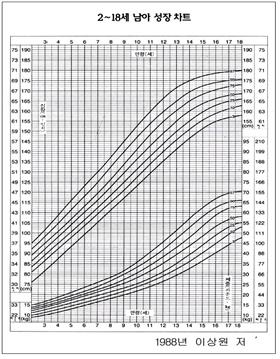
그림 3-177. 2~18세 한국 남아들의 체중과 신장의 성장차트와 백분위수.
Copyright ⓒ 2012 John Sangwon Lee, MD., FAAP
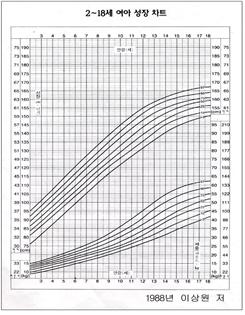
그림 3-178. 2~18세 한국 여아들의 체중과 신장의 성장차트와 백분위수.
Copyright ⓒ 2012 John Sangwon Lee, MD., FAAP
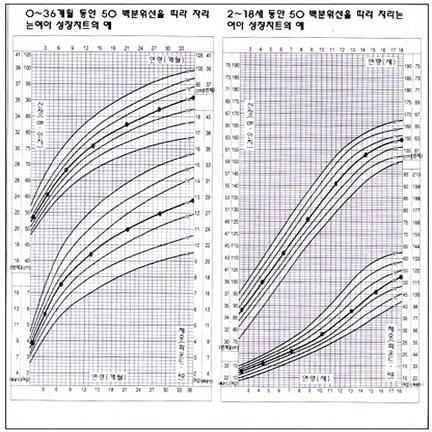
그림 3-179. 0~18세 여아 체중과 신장 성장차트.
50 백분위선을 따라 성장하는 성장차트 예.
Copyright ⓒ 2012 John Sangwon Lee, MD., FAAP
- 유아들의 체중과 신장을 잰다. 잰 체중 치와 신장 치를 성장차트 체중·신장 백분위선에 그려 넣고 그 아이의 체중과 신장이 성장차트 체중·신장 백분위선 상 어디에 있나 알아본다.
- 그 유아의 체중과 신장이 성장차트 백분위선을 따라 이전과 거의 같게 계속 같은 속도로 증가되면서 정상적으로 잘 자라나 알아본다.
- 4~5세 유아들의 대부분의 성장 속도가 정상적으로 느려서 부모들이 바라는 만큼 음식물을 많이 먹지 않는다.
- 그러나 정기 건강검진을 받을 때 잰 체중과 신장이 전과 거의 같이 성장 차트 체중·신장 백분위선을 따라 정상적으로 증가하면서 자라는 것을 볼 수 있다.
- 이 시기 유아들의 대부분은 잘 먹지 않는 것 같아도 전과 같은 체중·신장 백분위선을 따라 계속 성장하면 걱정할 필요 없다.
- 잘 먹지 않는 것 같지만 총체적으로 건강하면 6~12개월마다 정기 건강검진을 받고 또 체중과 신장을 재고 체중과 신장이 거의 같은 체중·신장 백분위선을 따라 전과 거의 같이 계속 잘 자라는 것을 볼 수 있다.
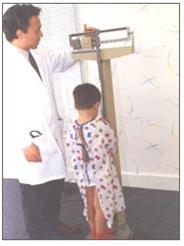
사진 3-180. 4세에 유아가 정기 건강검진을 받을 때 체중을 잰다.
Copyright ⓒ 2012 John Sangwon Lee, MD., FAAP
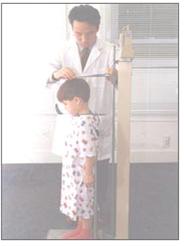
사진 3-181. 4세에 유아가 정기 건강검진을 받을 때 신장을 잰다.
Copyright ⓒ 2012 John Sangwon Lee, MD., FAAP
| 소아청소년 예측 체중 신장 계산공식 |
소아청소년 예측 체중 신장 계산공식 참조
| 4~5세 유아들의 발육 |
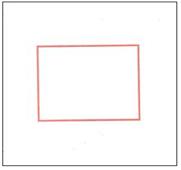
그림 3-182. 생후 4년 6개월 유아들의 대부분은 사각형을 보고 그릴 수 있다.
Copyright ⓒ 2012 John Sangwon Lee, MD., FAAP
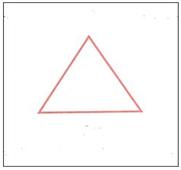
그림 3-183. 5세 유아들의 대부분은 삼각형을 보고 그릴 수 있다.
Copyright ⓒ 2012 John Sangwon Lee, MD., FAAP
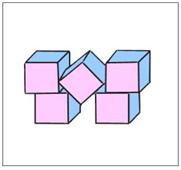
그림 3-184. 4세 유아들의 대부분은 장난감 정육면체 블록 5개로 다리 형태를 만들고 놀 수 있다.
Copyright ⓒ 2012 John Sangwon Lee, MD., FAAP
1. 4~5세 유아들의 신체 발육
- 멀리 뛸 수 있고
- 공을 머리 위로 던질 수 있다.
- 부모의 도움을 받지 않고 자신이 손을 씻을 수 있다.
2. 4~5세 유아들의 손 발육
- 대부분의 4세 유아들은 종이와 연필로 사람을 그리게 하면 적어도 신체의 두 부분을 그릴 수 있고 ◯(동그라미)를 보고 ◯을 그릴 수 있고.
- 손가락으로 셋까지 셀 수 있고.
- 자신이 단추를 낄 수 있고 혼자서 양치질을 할 수 있다.
- 장난감 정육면체 블록 4개로 다리를 만들고 놀 수 있다.
3. 4~5세 유아들의 언어 발육
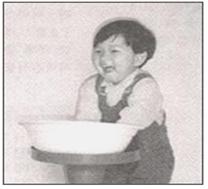
사진 3-185. 4~5세 유아들의 대부분은 자신이 얼굴과 손을 깨끗이 씻을 수 있고 수건으로 물기를 닦을 수 있다.
Copyright ⓒ 2012 John Sangwon Lee, MD., FAAP
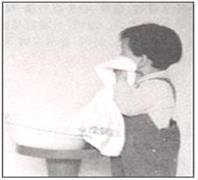
사진 3-186. 4~5세 유아들의 대부분은 자신이 얼굴과 손을 깨끗이 씻을 수 있고 수건으로 물기를 닦을 수 있다.
Copyright ⓒ 2012 John Sangwon Lee, MD., FAAP
- 최고 천 5백 개 정도 단어를 써서 말할 수 있다.
- ‘위에’ ‘아래에’ ‘옆에’ ‘뒤에’ 또는 ‘밑에’ 등 5개 전치사의 뜻을 이해할 수 있고, 전치사를 써서 말할 수 있다.
- 적어도 여섯 가지의 색을 정확히 분별할 수 있다.
4. 4~5세 유아들의 사회성 발육
- 부모의 도움이 없이 자신이 얼굴과 손을 깨끗이 씻을 수 있다.
- 젖은 손과 얼굴을 마른 수건으로 닦을 수 있다.
- 인사를 할 수 있다.
- 다른 아이들과 함께 놀기를 좋아한다.
- “생후 1개월~6세의 영유아들의 발육 이정표”를 참조.
| 4~5세 유아들의 장난감 |
장난감 참조
| 4~5세 유아들의 영양과 양호 |
- 부모와 집안 식구들과 같이 밥상 음식물을 하루에 세 번 주식으로 먹고, 아이의 식성에 따라 간식을 하루 2번 먹는다.
- 대부분의 유아들은 그동안사이에 엄마 아빠와 함께 집에 주로 있었다.
- 그러나 이 시기 유아들의 대부분은 집 이외 어린이 집이나 유치원 등에서 또래 유아들과 함께 지내든지 사람들이 많이 모인 장소에 가기 시작한다.
- 거기서 다른 또래 유아들이 앓고 있는 전염병의 원인이 되는 바이러스나 박테리아에 자주 감염될 수 있다.
- 그래서 감기 등 여러 종류의 바이러스 호흡기 감염 및, 또는 바이러스 위장염 등에 자주 걸려 앓을 수 있다.
- 교통, 추락, 화상, 익사, 약물중독, 독극물중독, 화학물질 중독 등으로 안전사고가 생기지 않게 특히 주의한다(부모도 반의사가 되어야 한다-소아가정간호 백과-제 2권 소아청소년 질병과 안전사고 예방-안전사고 예방).
- 승용차를 타고 유아 자녀와 어디 갈 때 규격에 맞는 승용차 안전의자에 유아를 앉히고 운전해야 한다.
- 4세에 정기 건강검진을 받는다.
- 4~7세에 5차 DTaP 백신 예방접종, 4차 불활성 소아마비(IPV) 백신 예방접종, 2차 홍역, 풍진과 유행성 이하선염(MMR) 백신 예방접종, 2차 수두 백신 예방접종(Varicella) 등을 권장 예방접종스케줄에 따라 받는다.
- ProQuad나 Pediarix 종합예방접종 백신으로 예방접종을 받을 수 있다.
- 필요에 따라 빈혈이 있는지 알아보고 혈액검사, 결핵에 걸려있나 알아보기 위해 투베르쿨린 결핵 피부 반응 검사하고, 요로 감염이 있나 알아보기 위해 소변검사 등을 받는다.
- 정기 건강검진을 정기적으로 해 줄 때마다 청력검사와 시력검사를 기본적으로 해준다.
- 소아자폐증이 있나 알아보기 위해 유아 자폐증 진단 일람표로 스크린검사를 받는다.
- 다음 정기 건강검진은 5세에 받으면 적절하다.
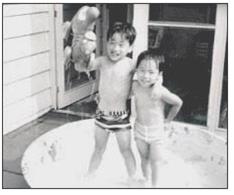
사진 3-187. 익사, 교통, 추락, 화상, 약물 중독, 독극물 중독, 화학물질 중독사고 등 안전사고가 생기지 않게 특히 주의해야 한다.
Copyright ⓒ 2012 John Sangwon Lee, MD., FAAP
| 4~5세 유아들의 자녀사랑 |
자녀사랑 참조
|
다음은“ 우리 집 아이의 발음이 제대로 나오지 않아, 언어발육”에 관한 인터넷 소아청소년 건강상담 질의응답의 예 입니다. |
Q&A. 우리집 아이의 발음이 제대로 나오지 않아, 언어발육
Q.
안녕하십니까, 저는 4살 난 여아를 둔 아빠입니다.
딸아이 때문에 걱정이 되어서 상담 좀 하려고 합니다.
다름이 아니라 딸아이가 말은 잘하는데 ㄱ 발음과 ㅅ 발음 ,ㅈ 발음이 ㄷ 발음이 되고 있습니다. 예를 들어 강가–당다로 발음이 됩니다. 부모입장에서는 걱정이 되는데 치료를 받아야 되는지요.
A.
서홍님
안녕하세요. 좋은 질문해 주셔서 감사합니다.
자녀의 나이, 성별, 과거 병력, 가족 병력, 진찰소견, 임상검사 등의 정보를 많이 알수록 답변을 드리는데 도움이 됩니다. 주신 정보를 참작해서 답변을 드리겠습니다.
연구에 의하면
2세 유아들의 말의 ⅓ 정도는 발음이 정확하고,
4세 유아들의 말의 75% 정도,
6세 학령기 아이들의 말의 89%의 발음이 정확하다고 합니다.
다시 말씀드리면 각 아이에 따라 언어의 발육에 차이가 납니다.
소아청소년과에서 청력검사, 성장발육 평가, 신체검사 등을 해주시고 모든 것이 정상이면 그 의사 선생님의 소개를 받아 언어교정 전문가로부터 언어 평가를 받고 언어 교정치료를 해 주시는 것이 좋을 것 같습니다.
해당 연령 성장 발육, 생후 1개월~6세 아이들의 발육 이정표. 부모도 반의사가 되어야 한다–소아가정간호 백과–제 18권 소아청소년 이비인후 질환–난청과 귀머거리 등을 참조하시기 바랍니다. 질문이 더 있으시면 다시 연락 주세요. 감사합니다. 이상원 드림
Growth and development of 4-5 year-old preschoolers
Growth of 4-5 year old peschoolers
Table 3-33. Percentiles of weight and height for 4-year-old Korean peschoolers percentile
표 3-33. 4세 된 한국 유아들의 체중과 신장의 백분위수
|
percentile
gender |
3 | 10 | 25 | 50 | 75 | 90 | 97 | |
| boy | weight (kg) | 11.30 | 12.80 | 13.80 | 14.80 | 16.00 | 17.10 | 18.10 |
| height(cm) | 86.0 | 91.0 | 94.8 | 98.0 | 101.7 | 104.3 | 107.5 | |
| girl | weight(kg) | 11.00 | 12.5 | 13.20 | 14.20 | 15.50 | 16.50 | 17.90 |
| height(cm) | 84.2 | 90.2 | 94.2 | 97.4 | 100.2 | 104.0 | 108.0 |
Table 3-34. Percentiles of weight and height of Korean infants aged 4 years and 6 months percentile 표 3-34. 4년 6개월 된 한국 유아들의 체중과 신장의 백분위수
|
percentile
gender |
3 | 10 | 25 | 50 | 75 | 90 | 97 | |
| boy | weight(kg) | 12.10 | 13.25 | 14.05 | 15.60 | 17.00 | 18.05 | 19.00 |
| height(cm) | 89.2 | 93.2 | 98.0 | 101.9 | 105.2 | 108.7 | 111.8 | |
| girl | weight(kg) | 12.00 | 13.00 | 14.00 | 15.00 | 16.10 | 17.30 | 18.80 |
| height (cm) | 88.2 | 92.9 | 96.3 | 99.9 | 103.2 | 106.0 | 109.6 |

Figure 3-177. Growth charts and percentiles of weight and height for Korean boys aged 2 to 18 years old.
Copyright ⓒ 2012 John Sangwon Lee, MD., FAAP

Figure 3-178. Growth charts and percentiles of weight and height for Korean girls aged 2 to 18 years. Copyright ⓒ 2012 John Sangwon Lee, MD., FAAP

Figure 3-179. Weight and height growth chart for girls aged 0-18 years. Example of a growth chart growing along with the 50th percentile. Copyright ⓒ 2012 John Sangwon Lee, MD., FAAP
• Weigh the preschoolers and measure their height. Draw the measured weight and height values on the growth chart weight/height percentile line and find out where the child’s weight and height are on the growth chart weight/height percentile line.
• Check whether the infant’s weight and height continue to increase at the same rate as before, along with the growth chart percentile, and grow normally.
• Most 4-5-year-olds grow normally so slowly that they don’t eat as much food as their parents would like.
• However, it can be seen that the weight and height measured during regular health check-ups increase normally along with the weight and height percentiles of the growth chart as before.
• Even if it seems that most preschoolers at this age do not eat well, there is no need to worry if they continue to grow along with the same weight and height percentile as before.
• If they do not seem to eat well, but if they are healthy overall, you will receive regular health check-ups every 6 to 12 months, weight and height, and you will see that your weight and height are almost the same and continue to grow almost as before along the weight and height percentiles.

Picture 3-180. At the age of 4, the infant is weighed at the regular health check-up. Copyright ⓒ 2012 John Sangwon Lee, MD., FAAP

Picture 3-181. At the age of 4, the child’s height is measured at regular health check-ups. Copyright ⓒ 2012 John Sangwon Lee, MD., FAAP
Predicted weight and height calculation formula for children and adolescents
Refer to the calculation formula for predicted weight and height for children
Development of peschooler children aged 4-5 years

Figure 3-182. Of Most preschoolers, 4 years and 6 months old can see and draw rectangles. Copyright ⓒ 2012 John Sangwon Lee, MD., FAAP

Figure 3-183. Most 5-year-olds can see and draw triangles. Copyright ⓒ 2012 John Sangwon Lee, MD., FAAP

Figure 3-184. Most 4-year-olds can build and play with five toy cube blocks. Copyright ⓒ 2012 John Sangwon Lee, MD., FAAP
1. Physical development of children aged 4-5 years
• able to jump far
• Can throw the ball overhead.
• Able to wash hands without parental help.
2. Hand development of children aged 4-5 years
• Most 4-year-olds can draw at least two parts of the body and draw
◯ by looking at the
◯ (circle) if they draw a person with paper and pencil.
• Count to three with your fingers.
• They can button yourself and brush your teeth by yourself.
• They can build and play with 4 toy cube blocks.
3. Language development of 4-5-year-olds

Picture 3-185. Most 4-5-year-olds can wash their face and hands thoroughly and dry with a towel. Copyright ⓒ 2012 John Sangwon Lee, MD., FAAP

Picture 3-186. Most 4-5-year-olds can wash their face and hands thoroughly and dry with a towel. Copyright ⓒ 2012 John Sangwon Lee, MD., FAAP
• Able to write and speak up to 1,500 words.
• Can understand the meaning of 5 prepositions such as ‘above’, ‘below’, ‘next to’, ‘behind’ or ‘below’, and speak using prepositions.
• Can identify at least six colors accurately.
4. Social development of 4-5-year-olds
• Able to wash face and hands thoroughly without parental help.
• Wet hands and face can be wiped with a dry towel.
• They can say hello.
• Likes to play with other children.
• See “Developmental Milestones for Infants 1 Month to 6 Years Old”. Toys for 4-5-year-olds toy reference
Nutrition and good health of children aged 4-5 years
• Together with parents and family members, eat food from the table three times a day, and snack twice a day according to the child’s appetite.
• Most of the infants were mostly at home with their mothers and fathers in the meantime.
• However, most of the children at this age begin to go to places where there are many people, whether they are staying with their peers at daycare centers or kindergartens other than at home.
• There, they can often be infected with viruses or bacteria that cause contagious diseases of other children of their age.
• So, they can often get sick with various types of viral respiratory infections, such as colds, or viral gastroenteritis.
• Be especially careful not to cause safety accidents due to traffic, falls, burns, drowning, drug poisoning, poison poisoning, chemical poisoning, etc. www.drleepediatrics.com – Volume 2 Children and Adolescent Diseases and Safety Accidents) Prevention – prevention of safety accidents).
• When traveling with them in a car, you must put him in a car seat that meets the standard and drive.
• Get regular health checkups at the age of four.
• 5th dose of DTaP vaccine at 4-6 years of age,
5th dose of inactive polio (IPV) vaccine,
2nd dose of measles, rubella, and mumps (MMR) vaccine at 4-6-year-old,
2nd dose of varicella vaccine (Varicella) at 4-6-year-old,
Receive according to the recommended vaccination schedule.
• They can get vaccinated with ProQuad, Vexelis, or Pediarix Combined Vaccine.
• If necessary, take blood tests to check for anemia, a tuberculin tuberculosis skin test to see if you have tuberculosis, and a urine test to check for a urinary tract infection.
• Whenever regular health check-ups are performed, hearing and vision tests are basically provided.
• Screening with the Infant Autism Diagnosis List to determine if a child has autism.
• It is appropriate to receive the next regular health checkup at the age of 5.

Picture 3-187. Special precautions must be taken to prevent accidents such as drowning, traffic, falls, burns, drug poisoning, poison poisoning, and chemical poisoning accidents. Copyright ⓒ 2012 John Sangwon Lee, MD., FAAP
4-5-year-old children love
See Love for Children
The following is an example of a Q&A for health counseling for children and adolescents on the Internet about “My child’s pronunciation is not coming out properly, language development”.
Q&A.
My child’s pronunciation does not come out properly, language development
Q
. Hello, I am the father of a 4-year-old girl. I’m worried about my daughter, so I’m trying to get some counseling. It’s no different, my daughter is good at speaking, but the ㄱ and ㅅ and ㄱ pronunciations are becoming the C pronunciation.
For example, it is pronounced as Ganga-Dangda. As a parent, I am worried, but should I receive treatment?
A.
Seo Hong
Good morning.
Thanks for the nice question.
The more information you know about your child’s age, gender, past medical history, family history, examination findings, and clinical tests, the more helpful it is to give you an answer. We will respond to you based on the information you have given us.
According to research
- About one-third of the words of 2-year-old children are pronounced correctly,
- About 75% of the speech of 4-year-old children,
- It is said that 89% of the words of 6-year-old school-age children are pronounced correctly.
In other words, the development of language varies from child to child.
In the Pediatric clinic, hearing tests, growth and development evaluations, physical examinations, etc., and if everything is normal, it would be better to get a referral from the doctor, get a speech evaluation from a speech correction specialist, and give speech orthodontic treatment.
Growth and development at the appropriate age, the developmental milestones of children aged 1 month to 6 years.
www.drleepediatrics.com – Volume 18 Children and Adolescent Otolaryngology – Hearing loss and deafness, etc. If you have any more questions, please contact us again. Thank you. Lee Sang-won
출처 및 참조문헌
- Nelson Textbook of Pediatrics 22ND Ed
- The Harriet Lane Handbook 22ND Ed
- Growth and development of the children
- www.drleepediatrics.com 제1권 소아청소년 응급 의료
- www.drleepediatrics.com 제2권 소아청소년 예방
- www.drleepediatrics.com 제3권 소아청소년 성장 발육 육아
- www.drleepediatrics.com 제4권 모유,모유수유, 이유
- www.drleepediatrics.com 제5권 인공영양, 우유, 이유식, 비타민, 미네랄, 단백질, 탄수화물, 지방
- www.drleepediatrics.com 제6권 신생아 성장 발육 육아 질병
- www.drleepediatrics.com제7권 소아청소년 감염병
- www.drleepediatrics.com제8권 소아청소년 호흡기 질환
- www.drleepediatrics.com제9권 소아청소년 소화기 질환
- www.drleepediatrics.com제10권. 소아청소년 신장 비뇨 생식기 질환
- www.drleepediatrics.com제11권. 소아청소년 심장 혈관계 질환
- www.drleepediatrics.com제12권. 소아청소년 신경 정신 질환, 행동 수면 문제
- www.drleepediatrics.com제13권. 소아청소년 혈액, 림프, 종양 질환
- www.drleepediatrics.com제14권. 소아청소년 내분비, 유전, 염색체, 대사, 희귀병
- www.drleepediatrics.com제15권. 소아청소년 알레르기, 자가 면역질환
- www.drleepediatrics.com제16권. 소아청소년 정형외과 질환
- www.drleepediatrics.com제17권. 소아청소년 피부 질환
- www.drleepediatrics.com제18권. 소아청소년 이비인후(귀 코 인두 후두) 질환
- www.drleepediatrics.com제19권. 소아청소년 안과 (눈)질환
- www.drleepediatrics.com 제20권 소아청소년 이 (치아)질환
- www.drleepediatrics.com 제21권 소아청소년 가정 학교 간호
- www.drleepediatrics.com 제22권 아들 딸 이렇게 사랑해 키우세요
- www.drleepediatrics.com 제23권 사춘기 아이들의 성장 발육 질병
- www.drleepediatrics.com 제24권 소아청소년 성교육
- www.drleepediatrics.com 제25권 임신, 분만, 출산, 신생아 돌보기
- Red book 29th-31st edition 2021
- Nelson Text Book of Pediatrics 19th- 21st Edition
- The Johns Hopkins Hospital, The Harriet Lane Handbook, 22nd edition
- 응급환자관리 정담미디어
-
소아가정간호백과–부모도 반의사가 되어야 한다, 이상원
-
Neonatal Resuscitation American heart Association
-
Neonatology Jeffrey J.Pomerance, C. Joan Richardson
-
Pediatric Resuscitation Pediatric Clinics of North America, Stephen M. Schexnayder, M.D.
-
Pediatric Critical Care, Pediatric Clinics of North America, James P. Orlowski, M.D.
-
Preparation for Birth. Beverly Savage and Dianna Smith
-
Infectious disease of children, Saul Krugman, Samuel L Katz, Ann A. Gershon, Catherine Wilfert
- 소아과학 대한교과서
- Growth and Development of Children, Eighth Edition, George H. Lowrey, Yearbook Medical Publishers
- Growth and Development of Children, Fifth Edition, E. H. Watson and G. H. Lowrey, Yearbook Medical Publishers
- Other
|
Copyright ⓒ 2015 John Sangwon Lee, MD, FAAP 미국 소아과 전문의, 한국 소아청소년과 전문의 이상원 저 “부모도 반의사가 되어야 한다”-내용은 여러분들의 의사로부터 얻은 정보와 진료를 대신할 수 없습니다. “The information contained in this publication should not be used as a substitute for the medical care and advice of your doctor. There may be variations in treatment that your doctor may recommend based on individual facts and circumstances. “Parental education is the best medicine.” |